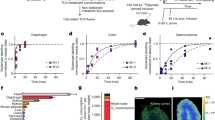Summary
The selectivity in the steady state uptakes of Rb+ and K+ has been studied in a number of normal and malignant rat tissues. The selectivity is minimal in erythrocytes and the two fastest-growing of four transplantable tumors, in which there is little discrimination between the two ions, and ranges upwards to a maximum Rb+ uptake in liver. In each tissue, the selectivity is independent of Rb+ concentration or of K+ deficiency (except in skeletal muscle). In liver slicesin vitro, reduction of energy metabolism by lowering the temperature or by the addition of metabolic inhibitors reduces the Rb+∶K+ discrimination proportionately much more than K+ transport. Diaphragm and slices of a transplantable tumor give similar results. With temperature reduction, there is a logarithmic relation between the Rb+∶K+ discrimination ratio and the respiration rate of liver slices. The results are quantitatively accounted for by simultaneous diffusion and metabolically coupled transport across a homogeneous membrane in which Rb+ transport is more closely coupled than that of K+ to a metabolic flux across the membrane. There is evidence that the tissue differences in Rb+∶K+ selectivity originate in the different levels of the coupling metabolic flux in different cell types and thus of the energy expenditure on ion transport. In contrast to the differences in steady state selectivity between Rb+ and K+, the initial ratio of uptakes of trace43K and86Rb, in otherwise steady state conditions, is close to unity in both liver and tumor slices, in agreement with theoretical calculations.
Similar content being viewed by others
References
Brauer, R. W., Balam, R. W., Bond, H. E., Carroll, H. W., Grisham, J. W., Pessotti, R. L. 1963. Reversible and irreversible changes in liver at temperatures approaching a critical upper level.Fed. Proc. 22:724.
Ciani, S., Eisenman, G., Szabo, G. 1969. A theory for the effects of neutral carriers such as the macrotetralide actin antibiotics on the electric properties of bilayer membranes.J. Membrane Biol. 1:1.
Cotlove, E., Holliday, H. A., Schwartz, R., Wallace, W. M. 1951. The effects of electrolyte depletion and acid-base disturbance on muscle cations.Amer. J. Physiol. 167:665.
Diamond, J. M., Wright, E. M. 1969. Biological membranes: the physical basis of ion and non-electrolyte selectivity.Ann. Rev. Physiol. 31:581.
Eisenman, G. 1962. Cation selective glass electrodes and their mode of operation.Biophys. J. 2:259.
Elshove, A., van Rossum, G. D. V. 1963. Net movements of sodium and potassium and their relation to respiration, in slices of rat liver incubatedin vitro.J. Physiol. 168:531.
Essig, A., Caplan, S. R. 1968. Energetics of active transport processes.Biophys. J. 8:1434.
Gaudin-Harding, F., Robin, D., Pinta, M. 1966. Minerals in the livers of protein-deficient rats.Nature 212:707.
Gaylarde, P., Sarkany, I. 1968. Ruthenium tetroxide for fixing and staining cytoplasmic membranes.Science 161:1157.
Katchalsky, A., Spangler, R. 1968. Dynamics of membrane processes.Quart. Rev. Biophys. 1:127.
Kedem, O., Caplan, S. R. 1965. Degree of coupling and its relation to efficiency of energy conversion.Trans. Faraday Soc. 61:1897.
Kilburn, D. G., Lilly, M. D., Webb, F. C. 1969. The energetics of mammalian cell growth.J. Cell Sci. 4:645.
Kilpatrick, R., Renschler, H. E., Munro, D. S., Wilson, G. M. 1956. A comparison of the distribution of42K and86Rb in rabbit and man.J. Physiol. 133:194.
Krebs, H. A. 1950. Body size and tissue respiration.Biochim. Biophys. Acta 4:249.
Limberger, J. 1963. Measurements of the membrane potential of normal hepatic parenchymal cells and hepato-carcinoma cells of the rat.Z. Krebsforsch. 65:590.
Ling, G., Schmolinske, A. 1954. Cellular selective ionic accumulation and permeability.Amer. J. Physiol. 179:656.
Loewenstein, W. R. 1967. Intercellular communication and tissue growth.J. Cell Biol. 33:225, 235.
Love, W. D., Burch, G. E. 1953. Comparison of42K,86Rb and134Cs as tracers of potassium in the study of the cation metabolism of human erythrocytesin vitro.J. Lab. Clin. Med. 41:351.
—, Romney, R. B., Burch, G. E. 1954. A comparison of the distribution of potassium and exchangeable rubidium in organs of the dog using Rb86.Circulation Res. 2:112.
Lubin, M., Schneider, P. B. 1957. Exchange of potassium for caesium and rubidium in frog muscle.J. Physiol. 138:140.
Mabille, H., Martin, J., Burg, C. 1961. Distribution and dynamics of86Rb in wistar rats.Compt. Rend. Soc. Biol. 155:561.
Meares, P., Ussing, H. H., 1959. The fluxes of sodium and chloride ions across a cation-exchange resin membrane.Trans. Faraday Soc. 55:142.
Müller, P. 1965. Potassium and rubidium exchange across the surface membranes of cardiac Purkinje fibres.J. Physiol. 177:453.
Nims, L. F. 1967. Biological barriers and material transfer.Advanc. Biol. Med. Physics 11:159.
Relman, A. S., Lambie, A. T., Burrows, B. A., Roy, A. M. 1957. Cation accumulation by muscle tissue: the displacement of potassium by rubidium and caesium in the living animal.J. Clin. Invest. 36:1249.
Richmond, C. R. 1958. Retention and excretion of radio-nuclides of alkali-metals by five mammalian species. Los Alamos Scientific Laboratory (University of California), Los Alamos, New Mexico, Report. No. LA-2207.
Schanne, O., Coraboeuf, E. 1966. Potential and resistance measurements of rat liver cellsin situ.Nature 210:1390.
Sjodin, R. 1961. Some cation interactions in muscle.J. Gen. Physiol. 44:929.
Skul'skii, I. A., Burovina, I. V. 1966. Types of stationary ion distribution of alkali metals in animals.C.R. Acad. Sci. U.R.S.S. 170:1185.
Steel, G. G., Adams, K., Barrett, J. C. 1966. Analysis of the cell population kinetics of transplanted tumours of widely-differing growth rate.Brit. J. Cancer 20:784.
Thurber, R. E., Thompson, A. M. 1967. Stationary-state sodium and potassium ion distributions in human erythrocytes.Amer. J. Physiol. 212:877.
Tyor, M. P., Eldridge, J. S. 1956. The comparative metabolism of Rb86 and K42 in humans.Amer. J. Med. Sci. 232:186.
Whittam, R., Ager, M. E. 1965. The connection between active cation transport and metabolism in erythrocytes.Biochem. J. 97:214.
—, Willis, J. S. 1963. Ion movements and oxygen consumption in kidney cortex slices.J. Physiol. 168:158.
Author information
Authors and Affiliations
Rights and permissions
About this article
Cite this article
Gilbert, I.G.F. The comparative transport of K+ and Rb+ in normal and malignant rat tissuesin vivo and in liver slices, diaphragm, and tumor slicesin vitro . J. Membrain Biol. 2, 277–299 (1970). https://doi.org/10.1007/BF01869865
Received:
Issue Date:
DOI: https://doi.org/10.1007/BF01869865




